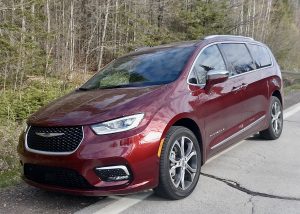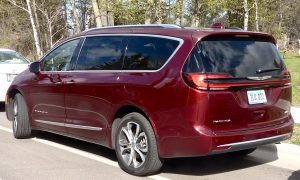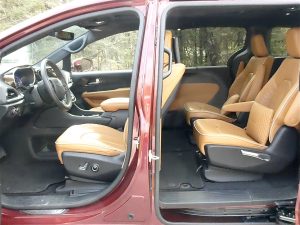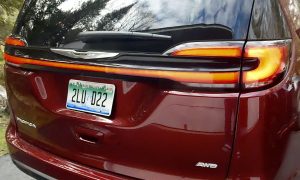Pacifica Pinnacle recalls Dylan, Indy, road-trips

Pacifica has added a top-of-the-line Pinnacle, which conjures up visions of road trips past, present and future.
By John Gilbert
As we age, memories seem to either fade away or become more vivid with passing years. In those cases, something may have to ignite that recollection, and the 2021 Pacifica Pinnacle is a perfect example, in this last week of May, 2021. It brought back an assortment of memories of road trips I’ve made over a few decades and ties them all together conveniently.
The new Pinnacle model of the Pacifica is loaded with luxury features that would make it perfect for a long road trip with family or good friends, and, in fact, it might take a jet airliner to approach — but not surpass — the ingredients Chrysler has loaded into the flagship version of the Pacifica. But its everlasting assets remind me of all the decades since Chrysler invented the minivan craze with its Caravan and Voyager, which became the ultimate family haulers.
The refinement of different mininvan models contributed to numerous road trips for our family, and this particular week, my review will be branching off into reveries encompassing timely looks at the music of Bob Dylan, trips by van from Duluth to the Indianapolis 500 nearly four decades ago, and even pre-minivan road trips home from college to Duluth.
During many years covering the Indy 500 for the Minneapolis Tribune, I had pretty well perfected a variety of methods of making that trip, and in 1987, circumstances broke just right so my younger son, Jeff, and UMD men’s hockey coach Mike Sertich, and his son, John all came along on my annual jaunt. It might be impossible for four humans to have such a crazy time, filled with enough laughs to last a lifetime. We laughed all the way down and all the way back in the 1987 model of the Caravan, eating a few pounds of yogurt-covered raisins as we cruised down and back, and exchanging good-natured one-liners with pedestrians on the streets while we were in Indianapolis to observe sensational racing, and the amazing act of getting 400,000 race fans into and out of the Indianapolis Motor Speedway. That race fits with the Pacifica review because while the 100th running of the Indy 500 is nowhere near the attraction it once was, it is this Sunday, May 30, 2021.
The newest Caravan back then had a 3.0 V6 supplied by Mitsubishi that made those vans run for up to and over 200,000 miles. A highlight was on race morning, police block off 16th Street, for several miles, turning all six lanes of two-way traffic into a well-regulated, one-way, six-lane conduit. There are no shortcuts and you can spend two or three hours in that nose-to-tail crawl. They do run a few motorcades of dignitaries into the place behind police escorts, however, and as one of them passed us, I seized a weird urge and pulled into a break in the flow, crossing the median to fit in behind the long line in what had been the oncoming lane. Amazingly, nobody saw us, and we fit right in, cruising along within the motorcade, passing an estimated 5,000 cars, and following right into the entrance. As we turned in, I simply gestured to my media pass on the windshield, and they waved us in, and once inside I turned left to head for the press parking area. We had reduced the three hours in congested traffic to about 10 minutes. Sertie talks about that adventure to this day. As well as my eclectic taste in music down and back.

Beautiful; Velvet Red paint houses roadworthy vehicle for trip to Indy 500, or 18-speaker audio to celebrate Bob Dylan’s 80th birthday.
Among the refinements in the evolution of the Caravan as it morphed into the Pacifica is the potent 3.6 V6 and refined transmission and suspension.
Of course, my infatuation with all things automotive means my road-trip history precedes minivans, back to the 1960s when I had transfered from UMD to the University of Minnesota to study journalism, and I had obtained a 1956 Studebaker Power Hawk coupe I found on a Duluth car lot, which was both dependable and fun, if a bit rusty. Perfect for dashing from a campus apartment a block from Dinkytown to visit mom and friends and a special girlfriend back home in Duluth. I’d leave as early as possible after classes on Friday afternoon, returning to Minneapolis Sunday night.
That was about 1962 or ’63, before Interstate 35 connected the two cities, and about the time a singer-songwriter named Bob Dylan, a couple years older, was performing at places such as the Scholar, a coffeehouse less than two blocks from the house where four of us roomed. I grew up loving music, but, as it turned out, I found Dylan’s voice too whiney and raspy, although one of my roommates, a fellow named Ron Leskinen, was consumed by Dylan. I refused to go across the street with him to watch Dylan perform, and before I realized my shortsightedness, Dylan was gone, to New York and overwhelming fame as the greatest songwriter in U.S. history.
I learned my mistake and changed my life thanks to a road trip, when I agreed that when I drove Ron home to Duluth one weekend, I would go inside his house on 4th Street and Lake Avenue, and sit down and listen to the words of an entire Dylan record album — “The Freewheeling Bob Dylan.”
That was Dylan’s second album, and we listened to songs like “A Hard Rain’s A-Gonna Fall.” In Ron’s living room on that afternoon, Dylan’s words made their own road trip off the vinyl and directly into my consciousness, my brain, my heart and my soul. And they’ve never left.

Quilted leather seats and finely-fitted interior components plus AWD give Pinnacle luxury beyond $55,000 sticker.
Everyone is picking out their favorite Dylan song this week, but most of those selecting aren’t old enough to have ever even listened to his earliest half-dozen albums — which contain the most riveting and lucid wordscapes of all. That becomes relevant in this last week of May, 2021, because Dylan’s 80th birthday was celebrated worldwide on Monday, and to paraphrase one of Dylan’s earliest songs, “I never thought we could get very old.”
Some of Dylan’s early songs brought depth to the tough life on the Iron Range when he grew up in Hibbing. He chronicled a dream, about “riding on a train going west,” and falling asleep, dreaming about many of his first friends he’d never seen again. Another song issued a request that “If you’re traveling to the North Country fair, where the wind hits heavy on the borderline, remember me to one who lives there, for she once was a true love of mine.” And there I was, listening to those words while coming home and going away again, visiting my mom, then departing, leaving behind a true love among so many good friends who meant so much to me, and many of whom I’ve never seen again.
The irony is that as we sat in Ron’s house listening to those words, we were about six blocks from the hillside house where Bob Zimmerman’s parents lived when he was born, and where the family resided until moving to Hibbing when he was 6.
Everyone points to his top classics, like “The Times They Are A-Changing,” but my favorites were some of the less-known among his hundreds of songs, those which I recorded, first on 8-tracks and then cassettes, and then MP3s, for replaying on future road trips. Some of them are: “Girl of the North Country;” “Bob Dylan’s Dream;” “Just Like a Woman;” “It’s All Over Now, Baby Blue;” “It Takes a Lot to Laugh, It Takes a Train to Cry;” plus two of his angriest, “Masters of War;” and “With God on Our Side.” All, or most, of his more recent ventures have produced great entries, such as “Tangled Up in Blue,” but nothing can dislodge those early classics from their Pinnacle, so to speak.
Another fellow we went to high school with at Duluth Central was Louie Kemp, who wound up becoming Bob Dylan’s closest friend. At an early high school reunion, Louie and I talked and after he learned how much I admired Dylan, Louie said, “Would you ever want to meet him?” I assured him I would, and he said, “Would you want to just meet him, or write about him?” I wanted to meet Dylan under any circumstances, but I wasn’t about to reject the idea of writing about him, and when I told Louie that, he said well then he couldn’t introduce me to him, for the sake of Dylan’s privacy. I’ve never forgotten that, but I’ve made due with recordings, and seeing him in concert various times, including at Bayfront Festival Park in 1999, when he made a rare and memorable trip to his birthplace to perform with Paul Simon in an unforgettable concert under a canopy of what was either fog or a low-handing cloud, at about Aerial Bridge height..
Those reminiscences vault to the surface this week while listening to Dylan tributes on satellite radio, and thinking about road trips we could make in the Pacifica Pinnacle, where we could hear all those songs on the 18-speaker-and-subwoofer Harman Kardon audio system. It would be perfect to fill its caramel-colored leather seats with six people and lure them away from the wi-fi streamable video screens on the backs of the front bucket headrests for some meaningful music on a trip to, say, Indianapolis.
This test-Pacifica has come a long way from the earliest Caravans and Voyagers that captured the hearts and budgets of American consumers, and have continued to hang onto a diminishing but valid segment of the market from the SUV-crazed buyers who settle for less efficiency and spend considerably more money for luxury SUVs.
The Pacifica Pinnacle comes loaded, meaning its base price of $53,390 goes up only to $54,885 with the addition of destination cost. That price includes all the creature comforts you might want, with the leather seats, video screens, and even a hideaway vacuum cleaner stashed in the rear wall, as well as all the safety features and stability devices. They include lane departure alert and warning, and the ability to detect and avoid anything in the way up front or behind. It also has Park Assist, which will give you a no-hands parallel or perpendicular parking job better than you can do yourself.
This Pinnacle’s 3.6-liter V6 has variable valve-timing, and will allow the Pacifica to cruise at the EPA estimated 25 miles per gallon highway, even with all-wheel drive. The 3.6 is operated by a slick rotating knob on the console, governing the 9-speed automatic transmission, aided by paddle shifters on the steering wheel to ease manual overriding. The Pacifica launches forcefully and with 20-inch all-season tires on alloy wheels, everything comes together in perfect harmony with the vehicle, engine and transmission.

Quilted leather seats will house six, and note the video screens and leather cushions on the rear buckets.
The Pinnacle came in Velvet Red Pearlcoat, which set off the contrasting caramel-color quilted leather seats with class. The second-row buckets, accessed through sliding side doors, are heated and cooled like the front seats, and they fold forward and slide to make it easier to get into the way-back, which has split folding backrests that fold down flat, or tumble backwards into the neatly designed storage bin at the extreme rear. You could put a week’s groceries or a lot of luggage into that low, scooped out rear compartment if the seats are upright.
The sliding side doors open and close with only the slightest touch. If that isn’t enough opening for you, the sunroof is comprised of three separate panels, offering a new definition of the term panoramic. Everything fits tightly and securely, making the Pacifica Pinnacle the perfect conveyance for a couple of generations to make a road trip together, Sheltered from the Storm while cruising in optimum comfort perhaps on Highway 61 Revisisted, and enjoying a session of meaningful, or whimsical, songwriting at its timeless best.
We could even bring a sack of yogurt-covered raisins.



 John Gilbert is a lifetime Minnesotan and career journalist, specializing in cars and sports during and since spending 30 years at the Minneapolis Tribune, now the Star Tribune. More recently, he has continued translating the high-tech world of autos and sharing his passionate insights as a freelance writer/photographer/broadcaster. A member of the prestigious North American Car and Truck of the Year jury since 1993. John can be heard Monday-Friday from 9-11am on 610 KDAL(www.kdal610.com) on the "John Gilbert Show," and writes a column in the Duluth Reader.
John Gilbert is a lifetime Minnesotan and career journalist, specializing in cars and sports during and since spending 30 years at the Minneapolis Tribune, now the Star Tribune. More recently, he has continued translating the high-tech world of autos and sharing his passionate insights as a freelance writer/photographer/broadcaster. A member of the prestigious North American Car and Truck of the Year jury since 1993. John can be heard Monday-Friday from 9-11am on 610 KDAL(www.kdal610.com) on the "John Gilbert Show," and writes a column in the Duluth Reader.